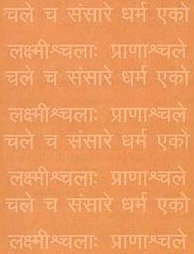Gurutva: 20 definitions
Introduction:
Gurutva means something in Buddhism, Pali, Hinduism, Sanskrit, Marathi, Hindi. If you want to know the exact meaning, history, etymology or English translation of this term then check out the descriptions on this page. Add your comment or reference to a book if you want to contribute to this summary article.
In Hinduism
Vaisheshika (school of philosophy)
Source: Wisdom Library: VaiśeṣikaGurutva (गुरुत्व, “heaviness”) is one of the additional guṇas (‘qualities’) added by Praśastapāda, on top of the seventeen guṇas in the Vaiśeṣika-sūtras. These guṇas are considered as a category of padārtha (“metaphysical correlate”). These padārthas represent everything that exists which can be cognized and named. Together with their subdivisions, they attempt to explain the nature of the universe and the existence of living beings.

Vaisheshika (वैशेषिक, vaiśeṣika) refers to a school of orthodox Hindu philosophy (astika), drawing its subject-matter from the Upanishads. Vaisheshika deals with subjects such as logic, epistemology, philosophy and expounds concepts similar to Buddhism in nature
Nyaya (school of philosophy)
Source: Shodhganga: A study of Nyāya-vaiśeṣika categoriesGurutva (गुरुत्व, “heaviness”) or Gurutvaguṇa refers to one of the twenty-four guṇas (qualities) according to Praśastapāda and all the modern works on Nyāya-Vaiśeṣika.—According to Nyāya-Vaiśeṣika, gurutva (heaviness) is the twelfth quality (guṇa). It is a general quality. Praśastapāda states in his bhāṣya that gurutva is the quality of water and earth and it is the cause of the act of falling. It is invisible but it is inferable through the action of falling. This quality is opposite of saṃyoga, prayatna and saṃskāra. Gurutva is eternal in the atoms of water and earth and non-eternal in the composite substances. Śivāditya gives the definition of it in his work that it is known as gurutva which has the generality of gurutvatva. It is the non-inherent cause of the first act of falling. It resides in only one substance.
According to Annaṃbhaṭṭa, gurutva is the non-inherent cause of the first act of a falling. It abides in earth and water. The word ādya is added in this definition to avoid over-pervasion to vega (velocity) because vega is the asamavāyikāraṇa of the subsequent falling.

Nyaya (न्याय, nyaya) refers to a school of Hindu philosophy (astika), drawing its subject-matter from the Upanishads. The Nyaya philosophy is known for its theories on logic, methodology and epistemology, however, it is closely related with Vaisheshika in terms of metaphysics.
Ayurveda (science of life)
Source: gurumukhi.ru: Ayurveda glossary of termsGurūtva (गुरूत्व):—Heaviness, Gravity

Āyurveda (आयुर्वेद, ayurveda) is a branch of Indian science dealing with medicine, herbalism, taxology, anatomy, surgery, alchemy and related topics. Traditional practice of Āyurveda in ancient India dates back to at least the first millenium BC. Literature is commonly written in Sanskrit using various poetic metres.
Shaktism (Shakta philosophy)
Source: Google Books: ManthanabhairavatantramGurutva (गुरुत्व) refers to the “teacher’s being”, according to the Manthānabhairavatantra, a vast sprawling work that belongs to a corpus of Tantric texts concerned with the worship of the goddess Kubjikā.—Accordingly, “The plane of the One-footed (ekapāda i.e. the letter E) is where the Skyfarer is in the Skyfarer within the Cavity of the Hair. Śrīdeva is above Meru (the triangle above the head) (merupaścima) in the essential nature of the Void, which is the threefold measure (of energy). (This is) where everything consists of Space and is the Cavity (vivara), which is the nectar of Fire (vāḍava). There, above, in the Void is the supreme god. (He is) the moonbeam (candrāṃśu) that, well-fixed, oozes (nectar). The (energy of the) Full Moon (pūrṇamāsā) resides as the teacher’s being (gurutva) on the plane of the Skyfarer”.

Shakta (शाक्त, śākta) or Shaktism (śāktism) represents a tradition of Hinduism where the Goddess (Devi) is revered and worshipped. Shakta literature includes a range of scriptures, including various Agamas and Tantras, although its roots may be traced back to the Vedas.
Shaivism (Shaiva philosophy)
Source: SOAS University of London: Protective Rites in the Netra TantraGurutva (गुरुत्व) refers to “being the head of the family” (of all stages of life), according to the Netratantra of Kṣemarāja: a Śaiva text from the 9th century in which Śiva (Bhairava) teaches Pārvatī topics such as metaphysics, cosmology, and soteriology.—Accordingly, [verse 19.85cd-87, while describing the ritual that protect the king and his kingdom]—“This [pūjā] should prevent all suffering to arise in [the one who performs it]. [The Mantrin] should perform [it] for his devoted wives, children, and his devoted pupils; he should not practice it otherwise. [When he conducts the pūjā, he should do so] on behalf of kings and their offspring because, the king is always the head [of the family] of all stages of life (sarvāśrama-gurutva) [i.e., the king is always the head of all families in the kingdom, regardless of the status of his subjects]”.

Shaiva (शैव, śaiva) or Shaivism (śaivism) represents a tradition of Hinduism worshiping Shiva as the supreme being. Closely related to Shaktism, Shaiva literature includes a range of scriptures, including Tantras, while the root of this tradition may be traced back to the ancient Vedas.
Yoga (school of philosophy)
Source: ORA: Amanaska (king of all yogas): A Critical Edition and Annotated Translation by Jason BirchGurutva (गुरुत्व) refers to “one who has the qualities of a guru”, according to the Gorakṣasiddhāntasaṅgraha, a text dealing with Yoga quoting from approximately seventy-two sources including the Amanaska Yoga treatise.—Accordingly, [while describing the true Guru]: “Therefore, since [the attributes of a guru] are beyond [mundane] attributes, only one who is beyond religious observance has the qualities of a guru [who] bestows liberation (muktiprada-gurutva), and no other [person] whatsoever [can have them]. [This] is frequently explained in scripture [...]”.

Yoga is originally considered a branch of Hindu philosophy (astika), but both ancient and modern Yoga combine the physical, mental and spiritual. Yoga teaches various physical techniques also known as āsanas (postures), used for various purposes (eg., meditation, contemplation, relaxation).
In Buddhism
General definition (in Buddhism)
Source: Wisdom Library: Dharma-samgrahaGurutva (गुरुत्व, “heavy”) refers to one of the “eleven tangibles” (spraṣṭavya) as defined in the Dharma-saṃgraha (section 38). The Dharma-samgraha (Dharmasangraha) is an extensive glossary of Buddhist technical terms in Sanskrit (e.g., gurutva). The work is attributed to Nagarjuna who lived around the 2nd century A.D.
Languages of India and abroad
Marathi-English dictionary
Source: DDSA: The Molesworth Marathi and English Dictionarygurutva (गुरुत्व).—n (S) Weight &c. See and form from the adj guru. Adopted in science to render Gravity.
Source: DDSA: The Aryabhusan school dictionary, Marathi-Englishgurutva (गुरुत्व).—n Weight. Gravity.
Marathi is an Indo-European language having over 70 million native speakers people in (predominantly) Maharashtra India. Marathi, like many other Indo-Aryan languages, evolved from early forms of Prakrit, which itself is a subset of Sanskrit, one of the most ancient languages of the world.
Sanskrit dictionary
Source: DDSA: The practical Sanskrit-English dictionaryGurutva (गुरुत्व).—
1) Weight, heaviness.
2) Burden, trouble.
3) Dignity, greatness; Uttararāmacarita 6.19; लोके गुरुत्वं विपरीततां वा स्वचेष्टितान्येव नरं नयन्ति (loke gurutvaṃ viparītatāṃ vā svaceṣṭitānyeva naraṃ nayanti) H.2.46; Śiśupālavadha 16.27.
4) Respectability, venerableness.
5) The office of a teacher; Kathāsaritsāgara 19.
6) Importance.
7) Universal gravitation.
Derivable forms: gurutvam (गुरुत्वम्).
See also (synonyms): gurutā.
Source: Cologne Digital Sanskrit Dictionaries: Shabda-Sagara Sanskrit-English DictionaryGurutva (गुरुत्व).—n.
(-tvaṃ) 1. Sacredness, venerableness, respectability. 2. Greatness, magnitude. 3. Weight, heaviness. 4. Burden, trouble. E. guru and tva affix; also with tal, gurutā.
Source: Cologne Digital Sanskrit Dictionaries: Benfey Sanskrit-English DictionaryGurutva (गुरुत्व).—[guru + tva], n. 1. Heaviness, [Pañcatantra] 247, 13. 2. Dignity, [Raghuvaṃśa, (ed. Stenzler.)] 10. 65. 3. The condition of a teacher,
Gurutva (गुरुत्व).—[neuter] weight, heaviness, severity; prosodical length, importance etc. = [preceding]
Source: Cologne Digital Sanskrit Dictionaries: Monier-Williams Sanskrit-English Dictionary1) Gurutva (गुरुत्व):—[=guru-tva] [from guru] n. weight, heaviness, [Suśruta; Raghuvaṃśa; Pañcatantra]
2) [v.s. ...] (in prosody) length (of a vowel), [Taittirīya-prātiśākhya xxiv, 5]
3) [v.s. ...] burden, trouble, [Horace H. Wilson]
4) [v.s. ...] severity, violence (of medical treatment), [Suśruta]
5) [v.s. ...] dulness, [Sarvadarśana-saṃgraha xv, 158]
6) [v.s. ...] greatness, magnitude, [Horace H. Wilson]
7) [v.s. ...] respectability, dignity, venerableness, [Raghuvaṃśa x, 65]
8) [v.s. ...] the office of a teacher, [Mahābhārata v, 178, 44.]
Source: Cologne Digital Sanskrit Dictionaries: Yates Sanskrit-English DictionaryGurutva (गुरुत्व):—[guru-tva] (tvaṃ) 1. n. Greatness; sacredness; weight; trouble.
[Sanskrit to German]
Sanskrit, also spelled संस्कृतम् (saṃskṛtam), is an ancient language of India commonly seen as the grandmother of the Indo-European language family (even English!). Closely allied with Prakrit and Pali, Sanskrit is more exhaustive in both grammar and terms and has the most extensive collection of literature in the world, greatly surpassing its sister-languages Greek and Latin.
Hindi dictionary
Source: DDSA: A practical Hindi-English dictionaryGurūtva (गुरूत्व):—(nm) see [gurūtā; —keṃdra] the centre of gravity.
...
Kannada-English dictionary
Source: Alar: Kannada-English corpusGurutva (ಗುರುತ್ವ):—
1) [noun] = ಗುರುತೆ [gurute].
2) [noun] the quality or fact of being relatively heavier.
3) [noun] the position, status or duty of a teacher; the profession of a teacher; teachership.
4) [noun] (pros.) the state or fact of being long (said of a syllable).
5) [noun] (phys.) the force by which every mass or particle of matter, including photons, attracts and is attracted by every other mass or particle of matter; gravitation.
6) [noun] (phys.) the tendency of these masses or particles to move toward each other.
7) [noun] the effect of gravitation, esp. the falling of bodies to the earth.
Kannada is a Dravidian language (as opposed to the Indo-European language family) mainly spoken in the southwestern region of India.
Nepali dictionary
Source: unoes: Nepali-English DictionaryGurutva (गुरुत्व):—n. 1. mode or condition of being a guru; 2. importance; dignity;
Nepali is the primary language of the Nepalese people counting almost 20 million native speakers. The country of Nepal is situated in the Himalaya mountain range to the north of India.
See also (Relevant definitions)
Starts with: Garutvavegotkarsha, Gurutvaka, Gurutvakarshana, Gurutvakarshananiyama, Gurutvakarshanashakti, Gurutvakemdra, Gurutvamadhya, Gurutvamka, Gurutvashakti, Gurutvavade.
Ends with: Karyagurutva, Svayamagurutva, Svayamgurutva.
Full-text (+22): Viparitata, Guruta, Karyagurutva, Gurutvaka, Guna, Svayamgurutva, Apekshika, Amritahva, Viparitatva, Gurutv, Apekshik, Sprashtavya, Kakkhatatva, Chandobhasha, Sasambandhika, Kalkatatva, Vrittavali, Eleven Tangibles, Muktiprada, Avakshepana.
Relevant text
Search found 16 books and stories containing Gurutva, Guru-tva, Gurūtva; (plurals include: Gurutvas, tvas, Gurūtvas). You can also click to the full overview containing English textual excerpts. Below are direct links for the most relevant articles:
Nyaya-Vaisheshika categories (Study) (by Diptimani Goswami)
Qualities (12): Gurutva (Heaviness) < [Chapter 4 - Quality and Action]
Divisions of Quality < [Chapter 4 - Quality and Action]
Different types of Action (Karma) < [Chapter 4 - Quality and Action]
Philosophy of Charaka-samhita (by Asokan. G)
Twenty general physical attributes < [Chapter 2 - Fundamental Categories]
Enumeration of attributes (guṇa) < [Chapter 2 - Fundamental Categories]
Vakyapadiya of Bhartrihari (by K. A. Subramania Iyer)
Verse 3.9.28 < [Book 3 - Pada-kāṇḍa (9): Kāla-samuddeśa (On Time)]
Verse 3.14.327 < [Book 3 - Pada-kāṇḍa (14): Vṛtti-samuddeśa (On Ccomplex Formation)]
Sahitya-kaumudi by Baladeva Vidyabhushana (by Gaurapada Dāsa)
Text 7.57 < [Chapter 7 - Literary Faults]
Text 10.108 < [Chapter 10 - Ornaments of Meaning]
Text 6.3 < [Chapter 6 - Third-rate Poetry and Super-excellent Poetry]
Vaisheshika-sutra with Commentary (by Nandalal Sinha)
Sūtra 1.1.29 (Above continued) < [Chapter 1 - Of Substance, Attribute, and Action]
Siddhanta Sangraha of Sri Sailacharya (by E. Sowmya Narayanan)